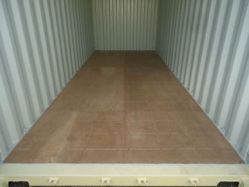
How can shipping container floors hold 15 years of heavy cargo loads and then be used for decades after for mobile storage? Shipping containers are manufactured to be solid, weatherproof steel boxes that will stand their ground throughout their years on the tough ocean sea. That's because their job is to secure various types of cargo that need to be shipped around the world.
Secure...that’s where the floors come in. Shipping container floors are carefully made specifically to withhold a variety of heavy cargo loads for 10-20 years. How you might ask?
First, a little background on the container frame... Shipping containers are constructed using steel in manufacturing facilities in China (mainly in Shanghai). Weathering COR-TEN steel is what’s used to be exact. Hence one reason why they’re strong in the first place. Machinery is used to cut sheets of steel for the sidewalls, roof, and floor panels - all of which are held together by a steel container frame. Once the pieces of steel are welded together, a rubber seal around the edges is used to make the container watertight and wind tight.
Now for the floor...The shipping container has steel beams as the base of the floor that connects to the sidewalls. The manufacturer then places thick pieces of marine plywood over the steel beams. Connecting the tropical plywood together, the manufacturer then carefully drills all the pieces together by hand. This wood makes the shipping container floor extremely tough and less likely to be dented. This wood fitting is also easily replaceable during repairs at depots. When the container is all put together, several examinations are done to ensure the container is properly constructed per ISO standards and specifications. These tests include stacking tests, sidewalls and front end wall strength tests, door strength tests, roof tests, floor tests, wind- and water-tight tests, and maximum gross weight tests.
Shipping containers are built to last. The floors, in particular, are designed to hold a wide range of cargo for shipment to countries all over the world. Some of the cargo loads that these floors have to support on the sea, by road, or by rail include dry and refrigerated goods, hazardous materials, bulk items, etc. That's why standard marine plywood container floors are designed to hold just about any storage items you need as long as they aren't contaminated or hazardous.
Depending on the typical cargo loads for a container (i.e. what items a container shipped), how many different ocean trade routes that container has traveled on, and the length of those journeys, there can be major or minor repairs that need to be done to the floor of a shipping container. Such repairs are generally completed at container yards (“depots”) between journeys. But if a used shipping container we receive doesn't have its floorboards intact, we also do repairs and replacements at our modification yards before delivering the storage unit to you. That's because all of our mobile/portable storage units at Box Storage Containers are all certified wind and watertight. So the floors have to be in good working condition.
If you want to ensure your shipping container will last years, and even decades, as an on-site mobile storage unit, then the condition of the floors is essential. The condition of the swing-out doors as well as the steel panels, posts and corners are also important for that matter. But if you only need a shipping container for a short period of time, then these factors may not be as big of a deal for you.
Have questions about shipping container floors? Or...have something to add to our list? Contact us today!
